Easter is here, a time to be with family, enjoy hot cross buns and maybe even a chocolate egg or two. If all that wears a little thin, the long weekend is also a great time to indulge in your passion – reading crime. Whether it’s in the shade of a favourite old tree or curled up by the fire, Easter probably isn’t the time for the latest blacker-than-coal Scandinavian noir. But, Golden Age detective fiction, now that will do nicely…
There is something comforting about a good Golden Age mystery. There are relatively few surprises, no gimmicks, nothing too serious and nothing too silly. Golden Age novels are neither too short nor too long, and written in such a way that you can reach the conclusion at the same time as the detective. They can be a bit like an egg hunt, really, so we’ve put together ten of the all-time best for Easter.
Although some of these novels deviate slightly from these rules, they are all delightful, captivating novels, with truly intriguing mysteries. These novels are remnants of a bygone era, when murders were puzzles, committed in drawing rooms by servants or jilted relatives. Often they’re solved by detectives who were brilliant eccentrics, gifted at getting to heart of the crime. Best of all, these books are available at all good secondhand bookstores, and – let’s face it – a lot of the really bad ones too.
So here are ten of the best Golden Age detective novels:
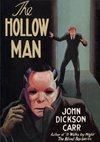 10 – The Hollow Man by John Dickson Carr (1935)
10 – The Hollow Man by John Dickson Carr (1935)
One of the few American writers to call the Golden Age style his own, Carr’s most famous novel was voted the best locked-room mystery ever in 1981. A mysterious stranger visits Professor Charles Grimaud while he is drinking at a local tavern, claiming to be an illusionist who can bring one of his dead brothers back. Grimaud tells him to leave, but a few days later a stranger arrives at Grimbaud’s house and is shown into his study. Minutes later gunshots are heard, and when the study door is broken down Grimbaud is found dying, with no sign of the killer or the weapon. Elements of horror and the supernatural creep into this novel in places, mainly as red herrings, but the eventual solution is typical Golden Age. Spoiler alert: Don’t read the book’s Wikipedia entry, it gives away the plot.
Buy now on Amazon
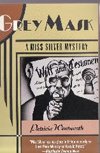 9 – Grey Mask by Patricia Wentworth (1928)
9 – Grey Mask by Patricia Wentworth (1928)
The first and the best of Wentworth’s Miss Silver series sees governess-turned-detective Miss Maud Silver employed by globetrotting Charles Moray to investigate the connection between his ex-fiancée and a chilling murder plan. Reluctant to bring the police in where love is involved, Miss Silver is the obvious next choice, and the old governess works her way into the gritty London underworld to find the truth behind the plot. The republished editions of Wentworth’s Miss Silver novels are a throwback to vintage pulp; compact paperbacks with dramatic painted covers, and make quite the collection, although not all 32 are of matching quality.
Buy now on Amazon
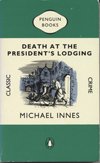 8 – Death at the President’s Lodging by Michael Innes (1937)
8 – Death at the President’s Lodging by Michael Innes (1937)
Scandal arises at St Anthony’s College when the president is found murdered in his locked lodgings, and the only ones holding the keys were the college fellows. The locked room is, of course, a recurring theme in Golden Age detective fiction, adding a level of intrigue to the mystery of just how the seemingly impossible murder occurred. This Inspector Appleby novel differs from many of the others on this list in its distinct lack of female characters, although this was par for the course at a British college in the 1930s. Despite the small number of suspects (there are only ever seven, hence the American title – Seven Suspects) this mystery may leave readers scratching their heads as the clues unfold. It may be a hard one to solve, but it’s still a joy to read. Click here for an introduction to Michael Innes.
Buy now on Amazon
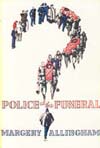 7 – Police at the Funeral by Margery Allingham (1931)
7 – Police at the Funeral by Margery Allingham (1931)
To say the Faraday family has some differences is like saying Agatha Christie is known for writing a couple of mysteries. The Faradays loathe each other: The Matriarch Caroline runs her house like a Victorian fiefdom, and her middle-aged children only hang around for the money. When a cousin disappears one Sunday after church, amateur detective Albert Campion attempts to find his way through the web of bitter resentment to the truth. As the cousin is found dead in a secluded stream, followed by the poisoning of one of the Faraday sisters, Campion finds himself digging deeper and deeper into the family’s secrets, in search of the truth. While this is not necessary Allingham’s book, it may be considered the most typically Golden Age of her novels.
Buy now on Amazon
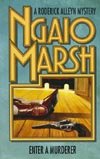 6 – Enter a Murderer by Ngaio Marsh (1935)
6 – Enter a Murderer by Ngaio Marsh (1935)
Unlike most of the authors on this list, Marsh is not British, although her characters are. Despite hailing from New Zealand, Marsh’s novels centre around London Metropolitan Police Inspector Roderick Alleyn. Many of her novels, including this one, also focus on Marsh’s other love, the theatre. The plot concerns the Unicorn Theatre’s new play, the script of which uncannily echoes a quarrel in the dressing room. When one actor shoots another dead with a gun, which the victim himself loaded with blanks, the drama gets all too real, and Inspector Alleyn must unravel the truth behind the act.
Buy now on Amazon
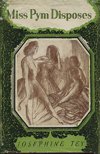 5 – Miss Pym Disposes by Josephine Tey (1946)
5 – Miss Pym Disposes by Josephine Tey (1946)
Of all the Golden Age novels I’ve read, this would have to be the most fun. It’s smart, well paced, with great atmosphere and the perfect amount of wit. Psychologist Miss Pym visits a college for women to give a guest lecture, and when she steps in to prevent a young student from cheating on her final exams, the act of compassion has unintended consequences. This is not Tey writing in the Golden Age per se – it was written in 1946 – and doesn’t star her famous detective Inspector Alan Grant. However the slow to start plot is ultimately as satisfying, if not more so, than the best of the Golden Age.
Buy now on Amazon
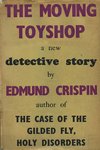 4 – The Moving Toyshop by Edmund Crispin (1946)
4 – The Moving Toyshop by Edmund Crispin (1946)
Another one to come late in the Golden Age, Edmund Crispin was actually the author’s pen name, taken from a character in a Michael Innes novel. Crispin’s novels are fun and literary, if a little unbelievable. The characters occasionally speak directly to the reader, something rare in crime fiction even today. Poet Richard Cadogan arrives late for a holiday in Oxford and stumbles across the body of a dead woman in a toyshop. However, upon returning with the police he finds both the body and the toyshop missing. With the help of eccentric professor Gervase Fen, Cadogan attempts to unravel the mystery of the moving toyshop in this fast-paced pastiche. With a poet and an academic as the central characters, Crispin’s most famous novel is more literary than detective, and is a fun throwback to a time when the Golden Age was beginning to lose its lustre.
Buy now on Amazon
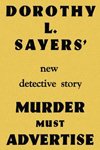 3 – Murder Must Advertise by Dorothy L Sayers (1933)
3 – Murder Must Advertise by Dorothy L Sayers (1933)
A 1930s advertising company might not seem the most exciting setting for a mystery novel, but there’s more to this one than meets the eye. Lord Peter Wimsey is called in to investigate after an ad man falls down the stairs of a respectable London agency. What first looks like an accident turns sinister as the succession of murders – five in all – lead Wimsey deeper and deeper into the sordid world of advertising. At a little under 400 pages this is on the long side for a Golden Age mystery, but Sayers is truly one of the greats, and this is her at her sly, delightful best. More by Sayers here.
Buy now on Amazon
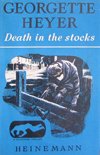 2 – Death in the Stocks by Georgette Heyer (1935)
2 – Death in the Stocks by Georgette Heyer (1935)
Heyer is known for her Regency romances, not her detective fiction, but even the previous three authors rarely compare to her when it comes to combining sly humour with clever mystery. A policeman on night patrol returns to find a corpse in evening dress locked in the stocks on the village green. The body is immediately recognised as unpopular eccentric Andrew Vereker, but the difficulty is narrowing down which of his enemies could have committed the crime. Superintendent Hannasyde must get to the bottom of Vereker’s corrupt, eccentric and unpopular family, to find out which of his detractors wanted him dead badly enough to commit the deed.
Buy now on Amazon
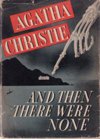 1 – And Then There Were None by Agatha Christie (1939)
1 – And Then There Were None by Agatha Christie (1939)
Choosing one Agatha Christie novel is no easy task. The Queen of Crime penned 66 mystery novels during her lifetime, many starring her famous detectives Hercule Poirot or Miss Marple. For me it was a toss-up between The Murder of Roger Ackroyd and And Then There Were None, two of Christie’s most popular novels, both of which break the rules of Golden Age detective fiction in at least one significant way. And Then There Were None (also known by two other titles, both of which show that the Golden Age of detective fiction was also a Golden Age for racism) is a variation on the locked room theme – a locked island mystery. Here, ten individuals who were complicit in the deaths of others, but escaped legal sanction, are convinced to travel to an island. They find a gramophone reading out a poem about ten little soldiers meeting their end. One by one they are found dead in circumstances that echo the poem. This novel varies from Christie’s others – and most other Golden Age novels – in that the detective does not appear until the end of the novel, and never really solves the mystery. This does not, however, mean that the reader can’t deduce what is going on, and still be surprised at the ending. More on Agatha Christie here.
Buy now on Amazon
Whatever you’re reading this weekend, the team at Crime Fiction Lover wish you a safe and happy Easter. Let us know what your favourite Golden Age novel is in the comments below.








Wow, resembles my Mom’s bookshelf! Thanks for the handy sampler
While I have loved reading all of these authors in the past there are so many good modern authors one wants to read I find it very difficult to go back to the “Golden Agers” any more.
To be perfectly honest while I recognize that “Golden Age” is more of a time than a description, I would have to say we are living in a golden age of crime writing right now.
Still, an interesting list and an interesting read.
It’s getting to be a case of too much choice, sometimes, isn’t it. That’s one of the reasons we’re around – to help people find the book that’s right for them.
Cheers for commenting – CFL
At least four of those would be in my top ten too. And I very much agree with your top choice.
Glad to see Heyer included here as she’s too often unfairly missed out.Her books have the merit of both disciplined length and delicious humour.
Another favourite is Cyril Hare whose legal mysteries abound in wry humour at the expense of the legal Establishment ( of whom Hare was himself a member! )
Michael Gilbert’s Smallbone Deceased is another ‘late entry’ that is pure essence of ironic whodunnitry!
A more obscure entry worth a mention is Francis Beeding’s death Walks in Eastrepps. Amazingly cunning.
Finally, as one ‘born out of time’, Catherine Aird’s delightfully bantering C.D. Sloan series exhibits all the virtues of the classic whodunit to perfection. Her ‘The Complete Steel’ is utterly charming as well as a dashed good puzzler.
Thank you for this list. While I also enjoy reading SOME modern crime fiction, the golden age stands alone. It is not comparable, it is different and is so fascinating for the sense of the era
I am mystified by the enduring respect and popularity of AND THEN THERE WERE NONE. I have always felt that the characters—given their perilous circumstances—behave in foolish ways that place themselves at great risk. Off they go—alone and secluded—to be picked off one by one. If they remain together, might this not possibly foil the plot against them? Safety in numbers, and all that…:)
What about Alexander Wilson and the hero of his books who is Chief of the Secret Service? A veritable, though happily married, James Bond of the 1930s.
I found Andrew Hallett’s comment to be analogous to saying “well, we really have better composers than Mozart these days”.